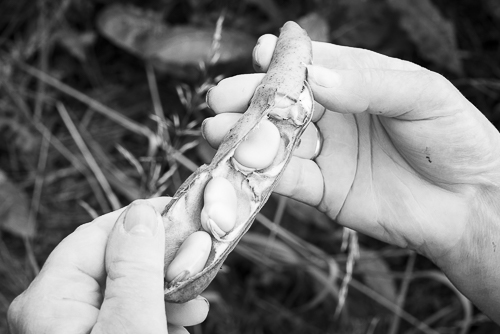In the countryside of Las Encartaciones, we went to visit Ana Mari Llaguno, a woman who has been growing vegetables in open air for 38 years. Actually, she moved into the house of her parents-in-law when she got married and her mother-in-law had already been growing vegetables next to their house for many years. In the Basque Country, it’s common that women are growing vegetables next to their houses, while men are working e.g. at factories or go to sea . However, while they are supposedly cultivating a small piece of land and cultivate only for domestic consumption, the fields of Mrs Llaguno amount to 3500 square metres, making her a small-scale producer who can sell her products e.g. at farmers’ markets.
All the cultivation is organic and she’s only irrigating young plants, while mature ones will have to fend for themselves. In addition, she sets aside fields for 4 years a time, letting them rest and the soil to recover as fallow land. Besides, she’s growing different vegetables on the other fields each year. That is, she practises crop rotation, which helps in reducing soil erosion and increases soil fertility and crop yield.
One of the most important vegetable she’s cutivating is a bean called «Alubia encartada» in Spanish and it’s included in the Ark of Taste of Slow Food Foundation for Biodiversity. The wild form of this plant is commonly found in undisturbed places such as bushes on roadsides, edges of forests or fields in the district of Las Encartaciones.
Beans were imported from North America, where Native Americans were growing mixed fields of maize, squash and beans, by European colonists.
To put it quite simply, growing maize (a tall grass), beans (a nitrogen-fixing legume) and squash (a low-lying creeper plant) together was a stroke of environmental genius. Maize maximizes photosynthesis, and grows straight and tall. Beans use the stalks for structural support and to gain greater access to sunlight; at the same time they bring atmospheric nitrogen into the system, making the nitrogen available to maize. Squash performs best in shady, humid places, and that is the type of microclimate provided by the corn and beans together. Further, squash decreases erosion. Source.
Another edible plant, which is grown at this farm is «Pimiento choricero», a special kind of pepper that is used for instance to make «chorizo» but also for cooking many others dishes. «Chorizo» is a pork sausage, which is flavoured with this kind of pepper, giving it an orange-red colour. For cooking, it’s widely used in the Basque Country where cooks let the peppers stay in water for a few hours or boil them with the stock , then the skin and seeds are discarded, while the pulp is kept. The kind of Pimiento choricero cultivated in this farm is a local one, known as «Pimiento choricero de las Encartaciones», and it is very well known among the great chefs because it has plenty of pulp and it´s really tasty.
Zalla Violet onion, a kind of local red onion, is also grown at this farm, besides broad beans, both of which originated in the Middle East, then after some thousand years, they spread to Europe.
After having walked around the fields of the farm, we were shown two long beds, which were surrounded by small brick walls and partly covered by plastic. Inside the walls, the beds were almost covered by green salads. Most of the beds are used as seedbeds and the seedlings are sold to other vegetable growers. Ana Mari makes a big effort to maintain the old local seeds year after year and one can sense her pride when somebody recognises her work.
After having visited the fields and the beds, Mrs Llaguno and her husband showed us their cows and calves which lived inside an enclosure nearby. Mr Llaguno gave them whole breads, which turned out to be very popular. In fact, the breads were leftovers from a local bakery and since the customers prefer freshly made bread, the Llaguno couple get them for free.While we cut bread into slices before we can eat it, the cows ate them whole, looking very content at the same time.
A taco soup using vegetables similar to those grown by Mrs Llaguno is presented here.

